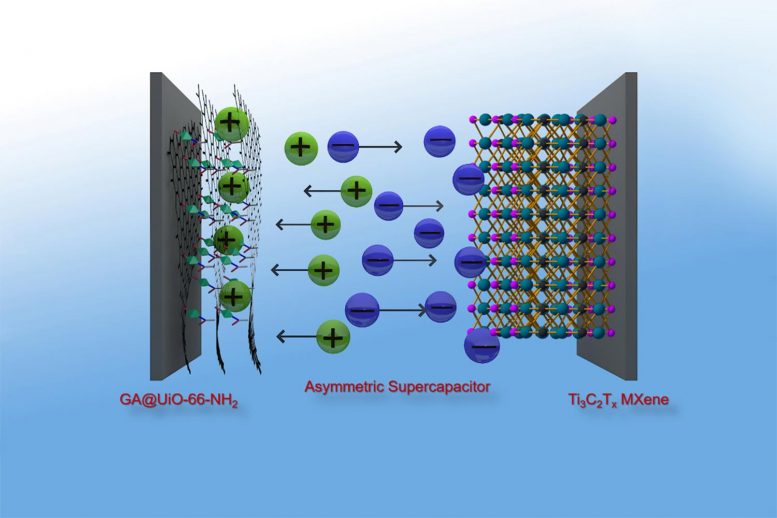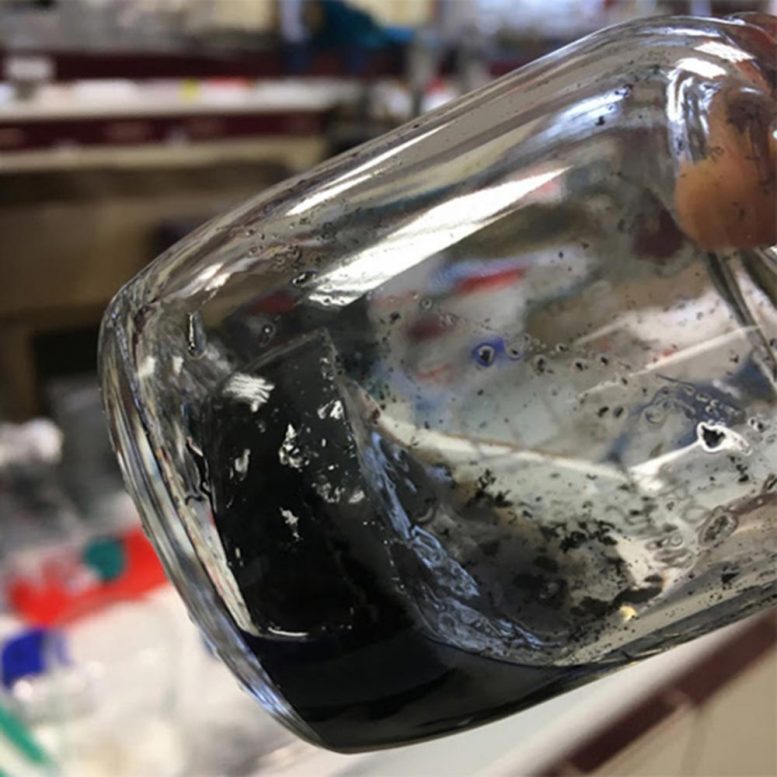
Graphene hybrid made from metal organic frameworks (MOF) and graphenic acid make an excellent positive electrode for supercapacitors, which thus achieve an energy density similar to that of nickel-metal hydride batteries. Credit: Prof. Dr. J. Kolleboyina / IITJ
A team working with Roland Fischer, Professor of Inorganic and Metal-Organic Chemistry at the Technical University Munich (TUM) has developed a highly efficient supercapacitor. The basis of the energy storage device is a novel, powerful and also sustainable graphene hybrid material that has comparable performance data to currently utilized batteries.
Usually, energy storage is associated with batteries and accumulators that provide energy for electronic devices. However, in laptops, cameras, cellphones or vehicles, so-called supercapacitors are increasingly installed these days.
Unlike batteries they can quickly store large amounts of energy and put it out just as fast. If, for instance, a train brakes when entering the station, supercapacitors are storing the energy and provide it again when the train needs a lot of energy very quickly while starting up.
However, one problem with supercapacitors to date was their lack of energy density. While lithium accumulators reach an energy density of up to 265 Kilowatt hours (KW/h), supercapacitors thus far have only been delivering a tenth thereof.
Sustainable material provides high performance
The team working with TUM chemist Roland Fischer has now developed a novel, powerful as well as sustainable graphene hybrid material for supercapacitors. It serves as the positive electrode in the energy storage device. The researchers are combining it with a proven negative electrode based on titan and carbon.

Graphene hybrids made from metal organic frameworks (MOF) and graphenic acid make an excellent positive electrode for supercapacitors, which thus achieve an energy density similar to that of nickel-metal hydride batteries. The black color indicates high electron mobility within the material. Credit: Prof. Dr. J. Kolleboyina / IITJ
The new energy storage device does not only attain an energy density of up to 73 Wh/kg, which is roughly equivalent to the energy density of a nickel metal hydride battery, but also performs much better than most other supercapacitors at a power density of 16 kW/kg. The secret of the new supercapacitor is the combination of different materials – hence, chemists refer to the supercapacitor as “asymmetrical.”
Hybrid materials: Nature is the role model
The researchers are betting on a new strategy to overcome the performance limits of standard materials – they utilize hybrid materials. “Nature is full of highly complex, evolutionarily optimized hybrid materials – bones and teeth are examples. Their mechanical properties, such as hardness and elasticity were optimized through the combination of various materials by nature,” says Roland Fischer.
The abstract idea of combining basic materials was transferred to supercapacitors by the research team. As a basis, they used the novel positive electrode of the storage unit with chemically modified graphene and combined it with a nano-structured metal organic framework, a so-called MOF.
Powerful and stable
Decisive for the performance of graphene hybrids are on the one hand a large specific surface and controllable pore sizes and on the other hand a high electrical conductivity. “The high performance capabilities of the material is based on the combination of the microporous MOFs with the conductive graphene acid,” explains first author Jayaramulu Kolleboyina, a former guest scientist working with Roland Fischer.
A large surface is important for good supercapacitors. It allows for the collection of a respectively large number of charge carriers within the material – this is the basic principle for the storage of electrical energy.
Through skillful material design, the researchers achieved the feat of linking the graphene acid with the MOFs. The resulting hybrid MOFs have a very large inner surface of up to 900 square meters per gram and are highly performant as positive electrodes in a supercapacitor.
Long stability
However, that is not the only advantage of the new material. To achieve a chemically stable hybrid, one needs strong chemical bonds between the components. The bonds are apparently the same as those between